
- •Contents
- •Foreword
- •How to use this book
- •Advisory boards
- •Contributing writers
- •Contributing illustrators
- •What is an insect?
- •Evolution and systematics
- •Structure and function
- •Life history and reproduction
- •Ecology
- •Distribution and biogeography
- •Behavior
- •Social insects
- •Insects and humans
- •Conservation
- •Protura
- •Species accounts
- •Collembola
- •Species accounts
- •Diplura
- •Species accounts
- •Microcoryphia
- •Species accounts
- •Thysanura
- •Species accounts
- •Ephemeroptera
- •Species accounts
- •Odonata
- •Species accounts
- •Plecoptera
- •Species accounts
- •Blattodea
- •Species accounts
- •Isoptera
- •Species accounts
- •Mantodea
- •Species accounts
- •Grylloblattodea
- •Species accounts
- •Dermaptera
- •Species accounts
- •Orthoptera
- •Species accounts
- •Mantophasmatodea
- •Phasmida
- •Species accounts
- •Embioptera
- •Species accounts
- •Zoraptera
- •Species accounts
- •Psocoptera
- •Species accounts
- •Phthiraptera
- •Species accounts
- •Hemiptera
- •Species accounts
- •Thysanoptera
- •Species accounts
- •Megaloptera
- •Species accounts
- •Raphidioptera
- •Species accounts
- •Neuroptera
- •Species accounts
- •Coleoptera
- •Species accounts
- •Strepsiptera
- •Species accounts
- •Mecoptera
- •Species accounts
- •Siphonaptera
- •Species accounts
- •Diptera
- •Species accounts
- •Trichoptera
- •Species accounts
- •Lepidoptera
- •Species accounts
- •Hymenoptera
- •Species accounts
- •For further reading
- •Organizations
- •Contributors to the first edition
- •Glossary
- •Insects family list
- •A brief geologic history of animal life
- •Index
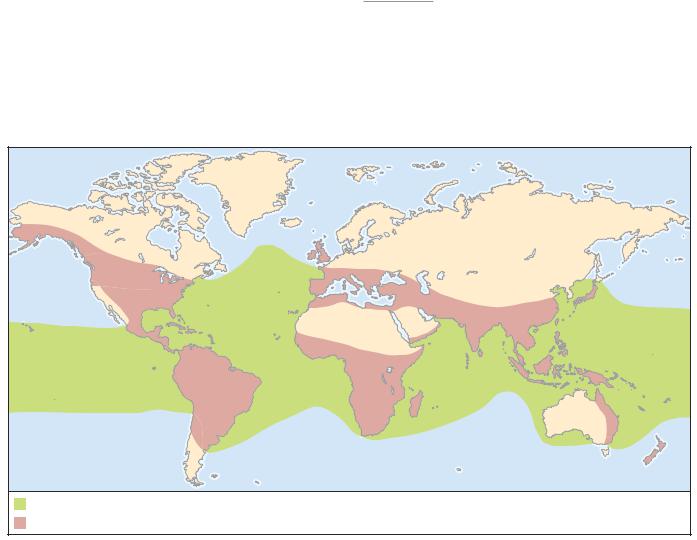
Vol. 3: Insects |
Order: Hemiptera |
Species accounts
Greenhouse whitefly
Trialeurodes vaporariorum
FAMILY
Aleyrodidae
TAXONOMY
Aleurodes vaporariorum Waterhouse, 1856, England.
OTHER COMMON NAMES
English: Glasshouse whitefly; Spanish: Mosca blanca de invernaderos.
PHYSICAL CHARACTERISTICS
Small, about 0.06 in (1.5 mm) long. Body and wings are powdered with white wax, which masks the yellowish to pale brown surface. Sexes are similar, both winged. Larvae scalelike and yellowish.
DISTRIBUTION
Cosmopolitan and intertropical; almost exclusively found in greenhouses in temperate zones.
HABITAT
Leaves (mostly on the underside) and twigs of a great variety of plants, including many cultivated ones.
BEHAVIOR
First-instar larvae walk for a couple of hours and then fix the beak at the underside of a leaf and remain there through four molts. The last instar serves as a puparium, inside which the
winged adult develops. Gregarious, mostly at the underside of leaves; adults fly quickly if disturbed.
FEEDING ECOLOGY AND DIET
Once the ambulatory first-instar larva finds a suitable place on a leaf, it buries its beak and starts feeding. Adults also suck sap but move around.
REPRODUCTIVE BIOLOGY
Mating and egg laying take place on the plants. The yellow eggs are glued to the surface in curved rows; they turn black before hatching. Reproduction occurs year-round.
CONSERVATION STATUS
Not threatened.
SIGNIFICANCE TO HUMANS
A serious pest in greenhouses. Large numbers reduce plant vigor. Sooty mold develops on the honeydew from adults and larvae, reducing marketability; some cultures must be abandoned.
Pea aphid
Acyrthosiphon pisum
FAMILY
Aphididae
TAXONOMY
Aphis pisum Harris, 1776. Type locality not specified.
Halobates micans
Trialeurodes vaporariorum
Grzimek’s Animal Life Encyclopedia |
267 |
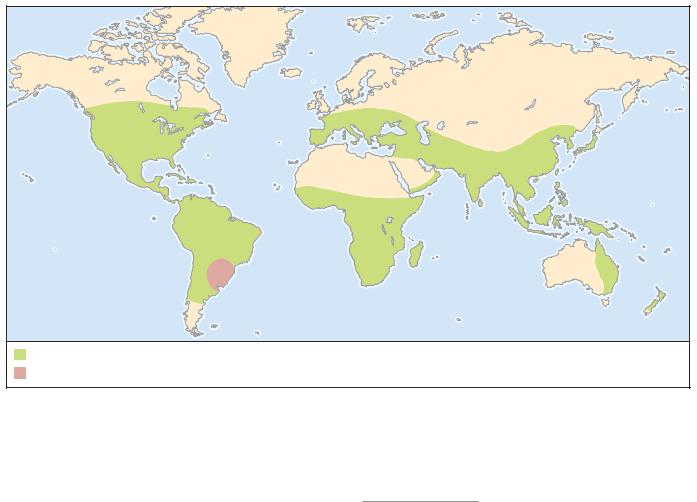
Order: Hemiptera |
|
|
|
Vol. 3: Insects |
|
|
|
|
|
|
|
|
|
|
|
|
|
|
|
|
|
|
|
|
Acyrthosiphon pisum
Dysdercus albofasciatus
OTHER COMMON NAMES |
SIGNIFICANCE TO HUMANS |
English: Green alfalfa aphid; French: Puceron vert, puceron du pois; German: Grüne Erbsenblattlaus; Spanish: Pulgón verde de alfalfa; Italian: Afidone verdastro del pisello; Portuguese: Piolho verde da ervilla.
It is adequately controlled in most countries, but it has been a serious pest of alfalfa crops.
PHYSICAL CHARACTERISTICS
Small, 0.08–0.16 in (2–4 mm) long. Wingless and winged individuals are light green, with red eyes. Antennae are slender and at least as long as the body. Legs long and slender. Wings, if present, are translucent. Abdominal siphons are long and slender. Larvae like small wingless adults.
DISTRIBUTION
Intertropical and temperate zones.
HABITAT
Canopy of leguminous weeds and shrubs. Prefer areas with alfalfa crops.
BEHAVIOR
In winter they hide as wingless parthenogenetic females on leguminous shrubs. In spring, winged migratory individuals appear. Adults and young form dense patches.
FEEDING ECOLOGY AND DIET
Adults and larvae take sap from leaves, stems, and flowers of alfalfa, pea, bean, clover, and other crops.
REPRODUCTIVE BIOLOGY
The species is permanently parthenogenetic in most temperate and subtropical zones, although in some areas one bisexual and many parthenogenetic generations alternate every year; females produce young, which in turn give off more young after a week.
CONSERVATION STATUS
Not threatened. Control is achieved chiefly by parasitoid wasps.
Giant water bug
Lethocerus maximus
FAMILY
Belostomatidae
TAXONOMY
Lethocerus maximus De Carlo, 1938, Santa Cruz, Bolivia.
OTHER COMMON NAMES
English: Giant electric light bug, giant toebiter, giant fishkiller; German: Riesenwasserwanze; Spanish: Chinche de agua gigante, cucaracha de agua gigante; Portuguese: Barata d’água gigante.
PHYSICAL CHARACTERISTICS
The largest bug: adults can exceed 4.3 in (110 mm). Color an almost uniform grayish-brown; individuals may be darker or paler. Forelegs are robust, adapted for grasping prey; the middle and hind legs are flattened, adapted to swimming. Ventral parts covered with very short hairs that retain air for breathing, which is taken in by two extensible posterior appendices. Sexes alike. Larvae are like adults but smaller and wingless.
DISTRIBUTION
Tropical South America from the West Indies to northern Argentina.
HABITAT
Margins of pools and lakes, especially dam lakes, in the water among plants.
268 |
Grzimek’s Animal Life Encyclopedia |

Vol. 3: Insects
BEHAVIOR
Prey, sometimes larger than the insects themselves, are grasped with the front legs, a poison is injected, and the digested tissues are sucked up. For taking in air, the giant water bug swims backward until the breathing appendages reach the surface. Courtship and egg laying have not been described. Males guard the eggs until they hatch. Dispersion flights occur at night, during which the bugs frequently are attracted to artificial lights.
FEEDING ECOLOGY AND DIET
A strong hunter of aquatic insects, fish, frogs, and tadpoles. Prey is killed by digestive saliva, and the liquefied tissues then are sucked up.
REPRODUCTIVE BIOLOGY
Mating takes place in the water among plants; clusters of several dozens eggs are laid around a twig above the surface. Larvae disperse at hatching.
CONSERVATION STATUS
Not threatened.
SIGNIFICANCE TO HUMANS
Predation on young fish may seriously constrain production in fish culture. Bites are very painful, but infrequent.
Spittle bug
Cephisus siccifolius
FAMILY
Cercopidae
TAXONOMY
Aphrophora siccifolia Walker, 1851, “West Africa” (probably erroneous).
OTHER COMMON NAMES
English: Frog-hopper, froth bug, spittle-insect, cuckoo’s spittle; Spanish: Cotorrita de la lluvia, cotorrita de las tipas.
PHYSICAL CHARACTERISTICS
Elongated and anteriorly rounded, the hind portion acutely stretched. About 0.4–0.5 in (10–12 mm) long. Dull brown, with indefinite darker areas and minute whitish dots. Larvae are plumper, soft-bodied, and whitish with dark markings.
DISTRIBUTION
Mexico through Argentina and Uruguay.
HABITAT
Canopy of several trees, mainly Leguminosae, in dense and open forests. Adults are solitary and larvae gregarious, living in the abundant froth they produce. Common in parks and avenues of cities.
BEHAVIOR
Adults fly frequently, mate, and search for egg-laying sites. As most homopterans do, spittle bug larvae quickly eliminate most of the water contained in the sap they consume. The water is excreted as watery feces, to which they add a thickening secretion and blow air bubbles into. The air bubbles produce a froth that builds up to form a large mass, which eventually begins to condense very slowly and produces drops that fall from
Order: Hemiptera
Lethocerus maximus
Delphacodes kuscheli
the canopy of trees to the ground. This process has given the bug its Spanish common name "cotorrita de la lluvia."
FEEDING ECOLOGY AND DIET
They feed on sap from twigs of trees; the amount removed is the highest known among the Homoptera.
REPRODUCTIVE BIOLOGY
Mating occurs on twigs, in which the eggs are embedded in summer. Larvae hatch the next spring and develop quickly, reaching adulthood in a few weeks.
CONSERVATION STATUS
Not threatened.
SIGNIFICANCE TO HUMANS
Abundant dropping of condensed froth sometimes causes trouble in cities.
Seventeen-year cicada
Magicicada septendecim
FAMILY
Cicadidae
TAXONOMY
Cicada septendecim Linné, 1758 Boreal America.
OTHER COMMON NAMES
English: Periodical cicada, locust (this name should be restricted to grasshoppers); French: Cigale de dix-sept ans.
Grzimek’s Animal Life Encyclopedia |
269 |
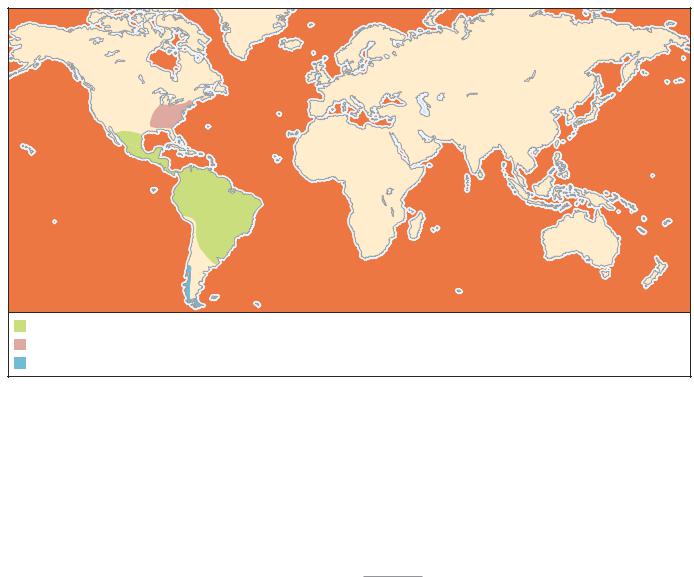
Order: Hemiptera |
Vol. 3: Insects |
Cephisus siccifolius
Magicicada septendecim
Peloridium hammoniorum
PHYSICAL CHARACTERISTICS |
CONSERVATION STATUS |
Plump, 1.37–1.57 in (35–40 mm) long. Dull dark brown to black and shiny, with reddish eyes and legs. Wings transparent, with well-marked, reddish veins. Venter has broad orange stripes. Antennae very short and hairlike. Legs short, adapted for walking; when at rest wings extend far beyond the rear of the abdomen. Larvae almost colorless, living underground.
DISTRIBUTION
United States east of the Great Plains.
HABITAT
Canopy of deciduous trees, in temperate forests and rainforests.
Not threatened, but destruction of the forests can affect populations.
SIGNIFICANCE TO HUMANS
If abundant on plantations, larvae are harmful to roots. End twigs replenished with eggs fail to grow the next season, especially in young trees. Choruses of cicadas may be annoyingly loud. The rigid periodical abundance is astonishing.
BEHAVIOR
Adults are diurnal. Males chirp loudly, attracting other males as well as females to the chorus. Larvae remain at the same site on a root for a long period of time and move stepwise to thicker roots as they grow and molt. At maturity they dig a tunnel to emerge. At sunset they emerge and molt to the adult form on stems. Most of every brood molts at the same time, thus appearing simultaneously in great numbers every 17 years at each location (but not always in the same year in distant locales).
FEEDING ECOLOGY AND DIET
Plants are pierced to suck liquid; adults feed from twigs and larvae from roots.
REPRODUCTIVE BIOLOGY
The males’ chirping attracts females, and mating occurs on stems in the end-to-end position. Eggs are embedded in plant tissues in the spring, up to twenty in each nest. Young larvae drop from the trees and burrow underground, searching for a suitable rootlet. They need 17 years to reach maturity.
Bed bug
Cimex lectularius
FAMILY
Cimicidae
TAXONOMY
Cimex lectularius Linné, 1758, “Habitat in domibus exoticus, sed ante epocham salutarem in Europa, at in Anglia vix ante 1670 visus teste Southall” [It lives in exotic countries’ housings, but before the healthful epoch in Europe, as it was seen in England somewhat before 1670, according to Southall].
OTHER COMMON NAMES
English: Red coat, mahogany flat, wall louse; French: Punaise des lits; German: Bettwanze; Spanish: Chinche de cama; Portuguese: Percevejo de cama.
PHYSICAL CHARACTERISTICS
Oval to round, very flat when not fed, globose and longer when fully fed. 0.16–0.19 (4–5 mm) long. Rusty brown to dull red. Rather short beak. Four-jointed antennae. Fore thorax roundly expanded around the rear of the head. Legs short. Flightless. Larvae look like small adults.
270 |
Grzimek’s Animal Life Encyclopedia |
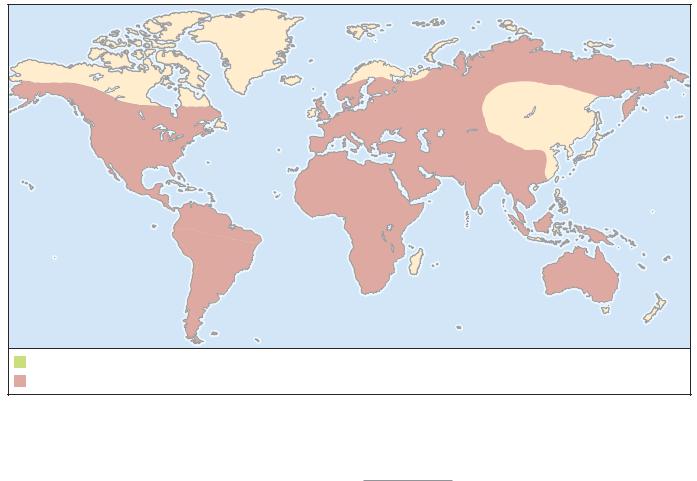
Vol. 3: Insects |
|
|
|
|
|
Order: Hemiptera |
|
|
|
|
|
|
|
|
|
|
|
|
|
|
|
|
|
|
|
|
|
|
|
|
|
|
|
|
|
|
|
|
|
|
|
|
|
|
|
|
|
|
|
|
|
|
|
|
|
Triatoma infestans
Cimex lectularius
DISTRIBUTION
Almost cosmopolitan, including cold areas, but rare or absent in large parts of Asia because of hybridization with another species.
able itching. Some people used (and perhaps still use) bed bugs as a medicine.
HABITAT
Human-made housings, mostly in bedrooms, crevices, bed frames, and mattresses or under wallpaper.
Tomato bug
Phthia picta
FAMILY
BEHAVIOR
They creep from their shelters and walk among bedding and clothing to the host, biting to take the blood of resting humans. They avoid humid surfaces.
FEEDING ECOLOGY AND DIET
Adults and larvae hide in the daytime and emerge at night, searching for human blood; they also may feed on poultry, dogs, and bats. They can take a blood meal four to five times as heavy as themselves. Starving individuals survive a long time, more than a year in cold climates, but do not reproduce.
REPRODUCTIVE BIOLOGY
Mating occurs in the shelters; the male mounts the female, puncturing her abdomen with his large clasper and discharging sperm into her cavity. Eggs are glued to any support at or near the bed. Young larvae start feeding soon.
CONSERVATION STATUS
Not threatened.
SIGNIFICANCE TO HUMANS
Bed bugs were known in ancient Egypt and classical Greece. Rapid expansion of populations can be expected in crowded conditions. Bed bugs can transmit some microbial parasites.
Biting itself is painless, but the saliva produces an uncomfort-
Coreidae
TAXONOMY
Cimex pictus Drury, 1770, Meridional America.
OTHER COMMON NAMES
English: Potato bug; Spanish: Chinche del tomate, chinche de la papa; Portuguese: Chupador do tomate.
PHYSICAL CHARACTERISTICS
Elongate, reaching some 0.59 in (15 mm) in length. Its abdomen is nearly triangular in shape. Dark grayish brown to almost black, frequently with a transverse yellowish to orange cross stripe. Long and slender antennae and legs. Sexes alike. Larvae wingless, brightly colored, with silky, whitish areas.
DISTRIBUTION
Most of tropical and temperate America from southern United States (California through Florida) through Uruguay and central Argentina in lowlands.
HABITAT
The canopy of bushes and dense grasses; frequently seen on tomato and other solanaceous crops.
BEHAVIOR
Adults are mostly solitary, moving about on plants and flying readily if disturbed. Larvae are gregarious, forming dense
Grzimek’s Animal Life Encyclopedia |
271 |
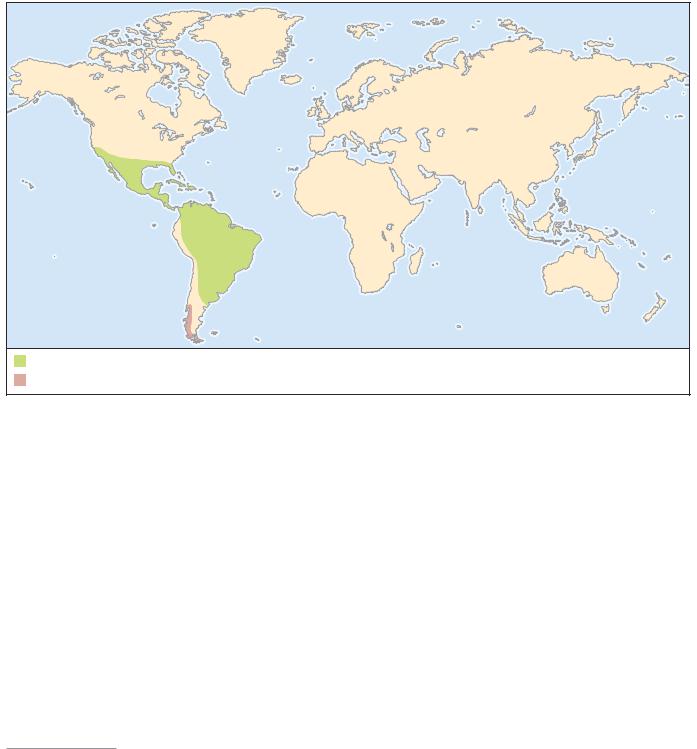
Order: Hemiptera |
Vol. 3: Insects |
Phthia picta
Gamostolus subantarcticus
groups, which remain for extended periods of time at the same place.
FEEDING ECOLOGY AND DIET
Adults and larvae take sap from shrubs and bushes, mainly from the unripe fruits; they prefer solanaceous species, but they are found on squash too.
REPRODUCTIVE BIOLOGY
Mating occurs on the plants, in an end-to-end position. Some 20–40 pale yellowish eggs are glued to leaves, in straight rows, and become ochre in color. After hatching, larvae remain aggregated almost until the last instar. Three to five generations per year.
CONSERVATION STATUS
Not threatened.
PHYSICAL CHARACTERISTICS
Elongate, some 0.24–0.28 in (6–7 mm) long. Dull brown, composed of very fine dark and pale vermiculate lines. Beak very short, not prominent. Forelegs spoon-shaped and adapted for sweeping small particles; middle legs long and very slender, adapted for anchoring to the bottom; hind legs extended to the sides like the oars of a boat, flattened, and with long hairs, adapted for swimming. Larvae similar to adults but much smaller and wingless.
DISTRIBUTION
Lowlands of southern South America, from central Bolivia, Paraguay, and southern Brazil to northern Patagonia, east of the Andes.
HABITAT
SIGNIFICANCE TO HUMANS
A minor pest, mainly of tomato crops; little effort is needed to control populations.
Shallow ponds and pools, especially rain pools, in water with few plants. A pioneer species.
BEHAVIOR
Water boatman
Sigara platensis
FAMILY
Corixidae
TAXONOMY
Sigara platensis Bachmann, 1962, Buenos Aires, Argentina.
OTHER COMMON NAMES
None known.
Most of their time is spent at the bottom, anchored to the substrate. Every few minutes they loosen from the bottom, reaching the surface by buoyancy; take air very quickly; and return to the bottom by swimming. They leave habitats that are drying up, flying in search of another one. They are attracted en masse to artificial lights.
FEEDING ECOLOGY AND DIET
Small prey are swept up with the forelegs and pierced by the buccal stylets; digestive juices are injected, and once the contents are digested they are swallowed. Very small items can be ingested whole. Algae and detritus may be taken too.
272 |
Grzimek’s Animal Life Encyclopedia |
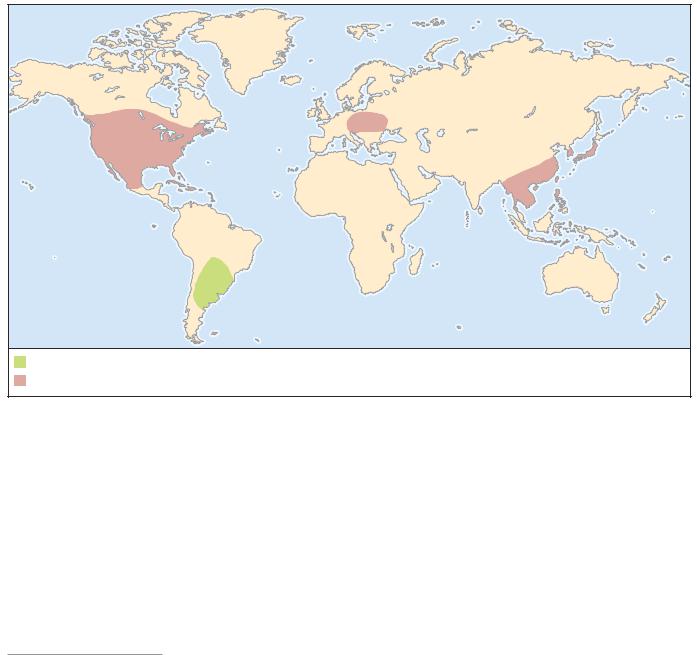
Vol. 3: Insects |
Order: Hemiptera |
Sigara platensis
Podisus maculiventris
REPRODUCTIVE BIOLOGY
Courtship begins with loud chirping by the male, answered gently by the female, which orients the insects to each other. The male mounts the back of the female, bends his abdomen laterally, and mates with her from the right side. Eggs are glued to any support. Males soon die; adult proportions are usually biased toward females.
CONSERVATION STATUS
as the ends of the tibiae contain conspicously flattened, denticulate spurs. Short-winged specimens are more common than winged ones. Sexes alike. Larvae resemble adults but are smaller and wingless.
DISTRIBUTION
Central Chile and central to northwestern Argentina, mainly in corn crop areas, up to an elevation of 6,562 ft (2,000 m).
Not threatened. |
HABITAT |
SIGNIFICANCE TO HUMANS |
On stems and blades of grasses. |
|
The appearance of masses of insects around artificial lights at night may be troublesome.
BEHAVIOR
Long-winged adults fly easily from grass to grass; all forms (both flying specimens and those that do not fly) and larvae walk along stems and blades and jump quickly if disturbed. Eggs are embedded in grass stems.
Delphacid treehopper
Delphacodes kuscheli
FAMILY
Delphacidae
TAXONOMY
Delphacodes kuscheli Fennah, 1955, Juan Fernández Islands, Chile.
OTHER COMMON NAMES
Spanish: Cotorrita del maíz.
PHYSICAL CHARACTERISTICS
Elongate, some 0.31–0.39 in (8–10 mm) long. Brownish to almost black, with a narrow yellowish stripe on the head. Forewings each have a black spot. Beak reaches the midlegs. Legs adapted for walking. Hind legs also adapted for jumping,
FEEDING ECOLOGY AND DIET
Larvae and adults suck sap from grasses, frequently of cereals.
REPRODUCTIVE BIOLOGY
Mating takes place on grasses. Slots are cut into blades of grass and two eggs are embedded in each slot; if the blades are too tough to be cut, the bugs move onto softer grass.
CONSERVATION STATUS
Not threatened.
SIGNIFICANCE TO HUMANS
An important cereal crop pest, causing heavy losses of yield, mainly by transmission of pathogenic viruses such as MRCud; this endemic disease is called “Mal de Río Cuarto del maíz” (Río Cuarto maize disease).
Grzimek’s Animal Life Encyclopedia |
273 |
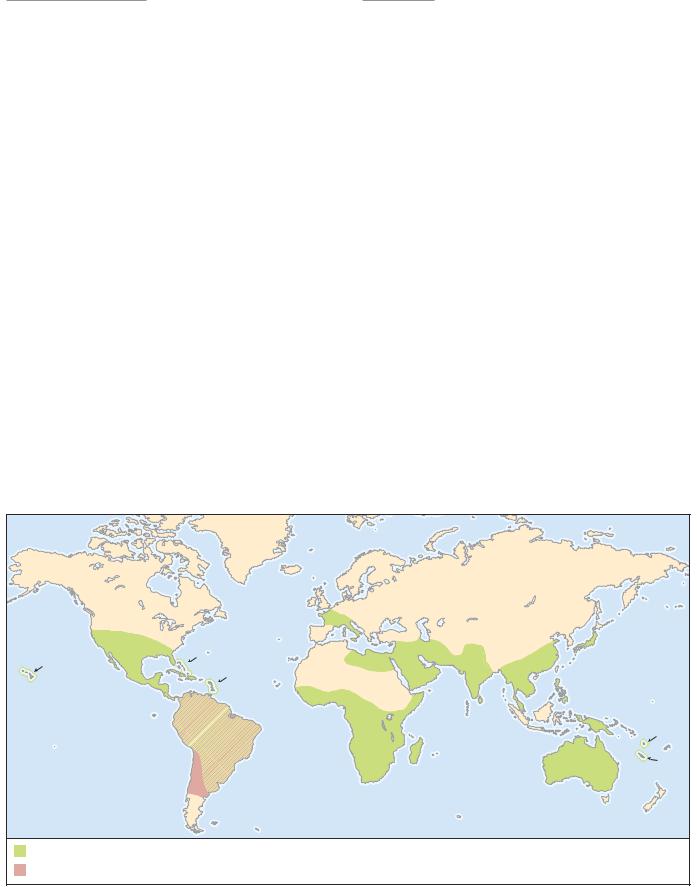
Order: Hemiptera
Unique-headed bug
Gamostolus subantarcticus
FAMILY
Enicocephalidae
TAXONOMY
Henicocephalus subantarcticus Berg, 1883, Isla de los Estados, Tierra del Fuego, Argentina.
OTHER COMMON NAMES
English: Four-winged fly.
PHYSICAL CHARACTERISTICS
Small, elongate, 0.24–0.31 in (6–8 mm) long. Dull yellowish to light brown in color. Prothorax is constricted twice, forming three lobes. Forelegs are thicker, adapted for grasping. Wings have somewhat reduced veins; both sexes are winged.
DISTRIBUTION
From southern tip of South America north to Osorno, Chile.
HABITAT
Hidden under stones in humid, cold-temperate forests.
BEHAVIOR
Nothing is known.
FEEDING ECOLOGY AND DIET
Generalized predator on small prey.
REPRODUCTIVE BIOLOGY
Little is known. Both sexes form dense swarms. Mating has not been observed. Eggs probably are laid in shelters.
CONSEZTION STATUS
Not threatened.
SIGNIFICANCE TO HUMANS
None known.
Vol. 3: Insects
Sea skater
Halobates micans
FAMILY
Gerridae
TAXONOMY
Halobates micans Eschscholtz, 1822, southern Pacific and Atlantic Oceans.
OTHER COMMON NAMES
English: Sea water-strider.
PHYSICAL CHARACTERISTICS
Plump, with a very short abdomen. About 0.16–0.18 in (4.0–4.6 mm) long. Body is dull brown to black with a very fine silvery coating; there is a pair of yellow marks on the head. Antennae are long. Forelegs short; middle and hind legs very long and slender. Wings absent.
DISTRIBUTION
Intertropical zones of all oceans, ranging to temperate latitudes.
HABITAT
The open ocean surface.
BEHAVIOR
They skate swiftly on the water surface, with the aid of a fringe of hair on the middle legs. Behavioral adaptations to the open ocean life may include a means of communication between individuals, to keep the population in one place.
FEEDING ECOLOGY AND DIET
Adults and larvae feed on planktonic microcrustaceans and fish larvae trapped in the surface film, and on floating jellyfish.
Antonina graminis
Hydrometra argentina
274 |
Grzimek’s Animal Life Encyclopedia |

Vol. 3: Insects
REPRODUCTIVE BIOLOGY
Mating and egg laying occur at the surface; the laying site may be any floating object, such as bird feathers, seaweed, timber, cork, coal, shells of cuttlefish, tar lumps, or even the feathers of living seabirds; eggs often are found attached in great numbers. There are five larval instars.
CONSERVATION STATUS
Not threatened.
SIGNIFICANCE TO HUMANS
None known.
Water measurer
Hydrometra argentina
FAMILY
Hydrometridae
TAXONOMY
Hydrometra argentina Berg, 1879, Buenos Aires, Argentina.
OTHER COMMON NAMES
English: Marsh treader, walking water-stick.
PHYSICAL CHARACTERISTICS
Slender and cylindrical with a very long head, the eyes placed midway along its length. About 0.39 in (10 mm) long. Uniformly pale brown. Antennae and legs are very slender. Longwinged, short-winged, and wingless individuals coexist. Sexes are alike. Larvae resemble adults but are much smaller and wingless.
Order: Hemiptera
DISTRIBUTION
Lowlands of most of South America on both sides of the Andes but not in Patagonia.
HABITAT
Surface of ponds and dead waters of small brooks, without plants or with a few plants.
BEHAVIOR
They walk slowly on the water surface in the daytime, searching for prey or for a mate. Long-winged individuals disperse by flight and are attracted to artificial lights.
FEEDING ECOLOGY AND DIET
Adults and larvae feed on small insects, aquatic or not—mainly those blown onto the water surface.
REPRODUCTIVE BIOLOGY
Mating takes place on the water surface. Large, elongated, ornamented eggs are glued singly to emerging sticks.
CONSERVATION STATUS
Not threatened.
SIGNIFICANCE TO HUMANS
Perhaps controls populations of mosquito larvae.
Creeping water bug
Ilyocoris cimicoides
FAMILY
Naucoridae
TAXONOMY
Nepa cimicoides Linné, 1758, Europe.
Nezara viridula
Ilyocoris cimicoides
Grzimek’s Animal Life Encyclopedia |
275 |

Order: Hemiptera
OTHER COMMON NAMES
English: Saucer water bug, water bee; German: Schwimmwanze.
PHYSICAL CHARACTERISTICS
Rounded, oval, and beetle-like, reaching 0.59 in (15 mm) in length. Dull green, with somewhat darker forewings. Beak is short and conical. Forelegs very robust, adapted for grasping prey; middle and hind legs have long swimming hairs. Venter is covered by air-retaining hairs. Sexes are alike. Larvae resemble adults but are much smaller and wingless.
DISTRIBUTION
Southern Palearctic region, from southern Britain and the northern Iberian Peninsula eastward through China.
HABITAT
Freshwater ponds among submerged plants.
BEHAVIOR
They swim swiftly around. Males chirp to attract females. They lie in ambush, awaiting and quickly attacking prey.
FEEDING ECOLOGY AND DIET
Adults and larvae prey on insects and snails. Prey is killed with a poison injected with the beak and is sucked empty.
REPRODUCTIVE BIOLOGY
Mating occurs on the bottom or on supports in the water. The male mounts the back of the female, grasps her with the forelegs and middle legs with his axis at a slight angle to hers, and copulates at the left side of her abdomen. Eggs are embedded in rows into stems or leaves.
CONSERVATION STATUS
Not threatened.
SIGNIFICANCE TO HUMANS
They readily bite if carelessly handled; bites are extremely painful. They may be a nuisance to fish fry in fishery ponds.
Vol. 3: Insects
Backswimmer
Notonecta sellata
FAMILY
Notonectidae
TAXONOMY
Notonecta sellata Fieber, 1851, Buenos Aires, Argentina.
OTHER COMMON NAMES
None known.
PHYSICAL CHARACTERISTICS
Spindle shaped and somewhat rounded in front; some 0.31–0.35 (8–9 mm) in length. Typically marked with dark blue and white, but colorless specimens occur. Beak is short and conical. Front and middle legs are rather short; hind legs are very long, extended to the sides like the oars of a boat and with long hairs adapted for swimming. Larvae are similar to adults but smaller and wingless.
DISTRIBUTION
Lowlands of southern South America from central Bolivia, Paraguay, and southern Brazil to northern Patagonia east of the Andes.
HABITAT
Shallow ponds and pools, especially rain pools, in water with few plants. Prefers turbid water.
BEHAVIOR
They swim slowly, always on their backs near the surface, searching for prey, but they escape very quickly if disturbed. They fly away from pools that are drying up. Often attracted to electric lights.
Notonecta sellata
Saldula coxalis
276 |
Grzimek’s Animal Life Encyclopedia |

Vol. 3: Insects
FEEDING ECOLOGY AND DIET
A generalist predator on small insects and crustaceans in the upper water layers. Prey is seized and held by the front and middle legs.
REPRODUCTIVE BIOLOGY
Mating takes place near the surface of the water, males mounting the (downturned) backs of females. Eggs are glued singly to submerged supports, such as twigs and even algal filaments. There are five larval instars.
CONSERVATION STATUS
Not threatened.
SIGNIFICANCE TO HUMANS
Some damage to fish fry may be expected in fish ponds. Perhaps controls populations of mosquito larvae.
Moss bug
Peloridium hammoniorum
FAMILY
Peloridiidae
TAXONOMY
Peloridium hammoniorum Breddin, 1897, Navarino Island (Tierra del Fuego), Chile.
OTHER COMMON NAMES
None known.
PHYSICAL CHARACTERISTICS
Small and flat, 0.16–0.19 in (4–5 mm) long. Dull colored, cryptic on mosses. Head and prothorax are expanded laterally. Forewings have coarse reticulation. Short-winged specimens are more common than winged ones.
DISTRIBUTION
From the southern tip of South America north to Chubut Province (Argentina) and Aysén (Chile).
HABITAT
Humid forests on the moss Polytrichum strictum.
BEHAVIOR
Almost nothing is known. Found quiescent or climbing among mosses.
FEEDING ECOLOGY AND DIET
Feed on liquids they suck from mosses.
REPRODUCTIVE BIOLOGY
Mating has not been studied. The smooth-shelled eggs are laid on mosses. Larvae cohabit with adults.
CONSERVATION STATUS
Not threatened.
SIGNIFICANCE TO HUMANS
None known.
Southern green stink bug
Nezara viridula
FAMILY
Pentatomidae
Order: Hemiptera
TAXONOMY
Cimex viridulus Linné, 1758, “Indiis” (may mean India, Southeastern Asia, or the East Indies).
OTHER COMMON NAMES
English: Southern green bug, green vegetable bug, tomato bug, bean bug; French: Punaise verte; Spanish: Chinche verde; Portuguese: Percevejo verde.
PHYSICAL CHARACTERISTICS
Broad and medium sized, 0.47–0.51 in (12–13 mm) long. Green, with dark red eyes. Other forms may be green with a yellowish collar, pink, golden, or liver brown. Antennae have five joints. All the legs are about the same shape and size, and adapted for walking. Basal part of the forewing is stiff; the distal one is translucent. Sexes are alike. Larvae wingless and brightly stained with red, yellow, white, or black.
DISTRIBUTION
Temperate and tropical zones of both hemispheres, but not in very cold and desert areas. Worldwide spread started some 250 years ago from an uncertain origin, perhaps eastern Africa or the Far East.
HABITAT
Canopy of many field and ornamental crops and weeds.
BEHAVIOR
Active mainly in the daytime, climbing to the canopy early in the morning; egg laying is mostly a nocturnal activity. Newly born larvae remain densely grouped; adults are solitary, flying readily if disturbed.
FEEDING ECOLOGY AND DIET
Sap is sucked from leaves, twigs, buds, growing shoots, flowers, and fruits; succulent parts are preferred. The list of food plants includes more than 80 species from more than 30 families; the species is a generalist. First-instar larvae do not feed.
REPRODUCTIVE BIOLOGY
Mating occurs on plants, with the partners in an end-to-end position. Egg batches with 30–130 (average 70–75) drumshaped, yellowish eggs in several rows are glued to the undersides of leaves; they turn pink and then red-orange. Females lay one or two egg batches. Up to five generations per year in warm climates but fewer in temperate areas.
CONSERVATION STATUS
Not threatened.
SIGNIFICANCE TO HUMANS
Severe damage is done in several cultures, with yield loss and damage to quality; viruses and disease-producing fungi are transmitted. Much effort is invested in controlling these pests. Adults are controlled mainly by species of parasitic flies; eggs are efficiently controlled (95%) by tiny wasps.
Spiny soldier bug
Podisus maculiventris
FAMILY
Pentatomidae
TAXONOMY
Pentatoma maculiventris Say, 1831, Louisiana, United States.
Grzimek’s Animal Life Encyclopedia |
277 |

Order: Hemiptera
OTHER COMMON NAMES
English: Spiny predator stink bug.
PHYSICAL CHARACTERISTICS
Elongate, about 0.35–0.55 in (9–14 mm) long. Dull yellow to tan with small black punctures and a dark spot at the rear; sometimes marked with purplish-red. Fore thorax with a prominent spine on each “shoulder.” Antennae are five-jointed. All the legs are about the same shape and size, and adapted for walking. Basal part of the forewing is stiff; the distal one is translucent. Sexes are alike. Larvae are broader, wingless, and dotted with red, cream, and black.
DISTRIBUTION
Temperate North America and the West Indies; introduced for pest control to European and Far East countries.
HABITAT
Canopy of trees and shrubs, several field crops, fruit orchards.
BEHAVIOR
Diurnal, surveying on foot the canopy of plants and searching for prey and egg-laying sites. Prey is located by sight, and tracks are followed with the antennae and beak. Adults fly quickly when disturbed. Young larvae are gregarious, dispersing progressively as they grow and molt; they quickly walk from plant to plant. A secretion produced by males attracts all instars acting as a cue to the presence of prey. Hibernation in litter, soil, or bark or under stones.
FEEDING ECOLOGY AND DIET
Adults and larvae prey mainly on caterpillars and beetle larvae but also on eggs, sucking them out; this is a fairly generalist species. Densely hairy caterpillars are avoided, but size of prey is unimportant. If prey items are bigger than the insects themselves, they slowly approach the prey, extend their beak forward, and pierce it from the side without touching it with their legs. Attacks sometimes are accomplished collectively, and other insects may come to share an already attacked prey item. If food is scarce, cannibalism occurs. Some water or juices are taken; if prey are scanty, they can survive a long time.
REPRODUCTIVE BIOLOGY
Mating occurs in the end-to-end position on plants and lasts many hours. Some 15–30 cream to black, barrel-shaped eggs are glued onto leaves in loose oval patches. They reproduce throughout their lifetime, which may last several months. Two or three generations per year are produced in temperate zones, but continuous reproduction takes place in warmer ones.
CONSERVATION STATUS
Not threatened.
SIGNIFICANCE TO HUMANS
Useful controllers of pests, chiefly the Colorado potato beetle and caterpillars. Reared to be released in the field. Their powerful pheromone is produced commercially to attract specimens to orchards. A light and uncomfortable irritation may occur on human skin, but true bites have not been reported.
Rhodesgrass mealybug
Antonina graminis
FAMILY
Pseudococcidae
Vol. 3: Insects
TAXONOMY
Sphaerococcus graminis Maskell, 1897, Hong Kong.
OTHER COMMON NAMES
English: Grass-crown mealybug, felted grass coccid, Rhodesgrass scale.
PHYSICAL CHARACTERISTICS
Ellipsoid to nearly spherical and about 0.11–0.16 in (3–4 mm) long. Purplish brown and covered dorsally by a felted, waxy, brittle, whitish to yellowish coating. Openings at the anterior and posterior ends expose the body, with a tubular, waxy white filament protruding from the anal end. First larval instar is ambulatory; the remaining instars and adults are legless.
DISTRIBUTION
Of Asiatic origin but now almost cosmopolitan, chiefly in warmer parts of temperate zones.
HABITAT
Crown, base, leaf sheaths, and stolons of forage grasses and lawns.
BEHAVIOR
The first instar larva walks and changes resting sites; thereafter, they are legless and remain in place for life, soon starting to secrete their felted, waxy coating.
FEEDING ECOLOGY AND DIET
Adults and larvae take sap from several grasses, chiefly cereals. Newly born larvae walk around and set themselves down in a leaf sheath, engaging in active feeding until death.
REPRODUCTIVE BIOLOGY
Parthenogenetic, without males. The female produces living larvae; only newly born larvae walk. There are about five generations per year.
CONSERVATION STATUS
Not threatened.
SIGNIFICANCE TO HUMANS
A minor pest of field crops. Yield losses can be expected in cereal cultures, as well as withering of lawns. The sugary feces favor sooty mold development.
Staining bug
Dysdercus albofasciatus
FAMILY
Pyrrhocoridae
TAXONOMY
Dysdercus albofasciatus Berg, 1878, Corpus, Misiones Province, Argentina.
OTHER COMMON NAMES
English: Cotton bug, cotton stainer; Spanish: Chinche negra (general), chinche guacha (general), chinche tintórea (Uruguay), chinchorro (Ecuador), churumbo (Peru); Portuguese: Barbeiro, percevejo manchador.
PHYSICAL CHARACTERISTICS
Nearly oval and elongate. Back is black, with a transverse whitish-yellowish stripe; venter is bright red. Antennae and legs are long and slender. Larvae smaller, wingless, bright red.
278 |
Grzimek’s Animal Life Encyclopedia |

Vol. 3: Insects
DISTRIBUTION
Tropical South America, following the distribution of their host plants.
HABITAT
Canopy and flowering and fruiting twigs of malvaceous shrubs.
BEHAVIOR
Adults are mostly solitary; larvae often are gregarious. Adults fly readily if disturbed.
FEEDING ECOLOGY AND DIET
Both adults and larvae prefer maturing or mature seeds; they inject saliva into them and suck the resulting liquid. When no fruits are available, they go to flowers, buds, or growing twigs.
REPRODUCTIVE BIOLOGY
They mate end to end. Eggs are laid on twigs or leaves. Larvae aggregate at the site and disperse progressively as they grow and molt.
CONSERVATION STATUS
Not threatened.
SIGNIFICANCE TO HUMANS
An uncommon secondary pest of cotton crops.
Order: Hemiptera
BEHAVIOR
Adults chirp by scraping the end of the beak against a ventral, transversely furrowed sulcus at the breast, the vibration being transmitted via the legs to the substrate. They orient themselves to their prey by heat and emission of carbon dioxide and to their shelters by the smell of their own excreta. Sleeping humans often are reached by flying. Adults may live two years.
FEEDING ECOLOGY AND DIET
Nocturnal, feeding on hosts as they sleep. They may feed on domestic animals, such as dogs and poultry. One blood supply is needed at each larval instar to reach adulthood.
REPRODUCTIVE BIOLOGY
Mating occurs in shelters. The whitish eggs drop to the ground and change to pink. There is one generation per year.
CONSERVATION STATUS
Not threatened.
SIGNIFICANCE TO HUMANS
An efficient transmitter of Chagas’ disease. People believe that having kissing bugs in the home will bring good luck and happiness, a belief that interferes with sanitary control measures.
Kissing bug
Triatoma infestans
FAMILY
Reduviidae
TAXONOMY
Reduvius infestans Klug, 1834, South America.
OTHER COMMON NAMES
English: Bloodsucking conenose; Spanish: Vinchuca (Bolivia, Paraguay, Chile, Argentina, and Uruguay), Chinchorro (Ecuador), Churumbo (Peru), Chinche negra, Chinche gaucha; Portuguese: Barbeiro.
PHYSICAL CHARACTERISTICS
Flat when unfed and globose when fully fed. Grows to 0.83–1.18 in (21–30 mm) long. Dark brown to almost black, with yellow square spots along the abdominal margins; legs somewhat paler and wings dark brown. Head long and cylindrical. Compound eyes are large and set nearer the base of the head; also a pair of prominent simple eyes. Antennae and legs are long and slender. Sexes similar. Larvae look like adults but are smaller, dull grayish brown, and wingless.
DISTRIBUTION
Most of tropical and temperate South America south of the equator, from northern Brazil and Ecuador through Patagonia (southern Argentina) up to an elevation of 13,123 ft (4,000 m); their distribution is linked to the movement of humans with baggage.
HABITAT
Human dwellings and poultry yards. Forest populations apparently are rare. Even if straw roofs or crevices are smoked—a process that repels most insects—the insects are still able to sustain their colony.
Shore bug
Saldula coxalis
FAMILY
Saldidae
TAXONOMY
Acanthia coxalis Stål, 1873, Cuba.
OTHER COMMON NAMES
None known.
PHYSICAL CHARACTERISTICS
Small, reaching 0.14–0.16 in (3.5–4 mm) in length; broad and flattened. Color varies widely from light to dark brown, mottled; lateral margins of pronotum are pale. Dorsum densely covered with short hairs. Legs are short, robust, adapted for walking and jumping. Wings complete or partially reduced (proportions of morphs vary). Forewings have well-marked veins and translucent membranes. Larvae are like adults but much smaller and wingless.
DISTRIBUTION
Texas (United States) through Chile and Argentina and the West Indies, principally along coasts; lives at elevations up to 11,480 ft (3,500 m) in Peru.
HABITAT
Salty, brackish, and freshwater swamps and muddy beaches of seas, lakes, and rivers; at floodtide they climb on grasses. Hardly seen on the mud and seldom collected.
BEHAVIOR
They walk, run, or jump quickly on the soil and fly readily if disturbed. Much time is spent grooming the legs and antennae.
FEEDING ECOLOGY AND DIET
They feed on dead insects on the soil or drive the beak into the surface mud and suck out small invertebrates such as insect larvae and small earthworms.
Grzimek’s Animal Life Encyclopedia |
279 |

Order: Hemiptera |
Vol. 3: Insects |
REPRODUCTIVE BIOLOGY |
CONSERVATION STATUS |
At mating the male positions himself side by side with the fe- |
Not threatened. |
male, grasping her ovipositor with the claspers. Eggs are laid |
|
on grass blades; they can withstand drowning. Reproduction |
SIGNIFICANCE TO HUMANS |
occurs year-round. |
None known. |
Resources
Books
Andersen, Nils M. The Semiaquatic Bugs (Hemiptera,
Gerromorpha): Phylogeny, Adaptations, Biogeography, and
Classification. Entomonograph 13. Klampenborg, Denmark:
Scandinavian Science Press, 1982.
Schaefer, Carl W. “Prosorrhyncha (Heteroptera and Coleorrhyncha).” In Encyclopedia of Insects, edited by V. H. Resh and R. T. Cardé. Amsterdam: Academic Press, 2003.
———, ed. Studies on Hemipteran Phylogeny. Thomas Say Publications in Entomology. Lanham, MD: Entomological Society of America, 1996.
—. “True Bugs and Their Relatives.” In Encyclopedia of Biodiversity, vol. 5. San Diego: Academic Press, 2000.
Schaefer, Carl W., and A. R. Panizzi, eds. Heteroptera of Economic Importance. Boca Raton, FL: CRC Press, 2000.
Schuh, R. T., and J. A. Slater. True Bugs of the World (Hemiptera: Heteroptera): Classification and Natural History.
Ithaca, NY: Cornell University Press, 1995.
Periodicals
Evans, J. W. “A Review of Present Knowledge of the Family Peloridiidae and New Genera and Species from New Zealand and New Caledonia (Hemiptera: Insecta).” Records of the Australian Museum 34, no. 5 (1981): 381–406.
Wheeler, W. C., R. T. Schuh, and R. Bang. “Cladistic Relationships among Higher Groups of Heteroptera: Congruence between Morphological and Molecular Data Sets.” Entomologia Scandinavica 24 (1993): 121–137.
Other
“Fulgoromorpha Lists on the Web.” November 30, 1999 [May 12, 2003]. <http://flow.snv.jussieu.fr/>.
“Halobates—Oceanic Insects.” June 26, 2002 [May 12, 2003]. <http://www.zmuc.dk/EntoWeb/Halobates/ HALOBAT1.HTM>.
“The International Heteropterist’s Society.” January 3, 2002 [May 12, 2003]. <http://entomology.si.edu/ihs/home.lasso>.
“Periodical Cicada Page.” December 16, 2002 [May 12, 2003].
<http://insects.ummz.lsa.umich.edu/fauna/Michigan_
Cicadas/Periodical/Index.html>.
“Scale Net.” March 19, 2003 [May 12, 2003]. <http://www.sel
.barc.usda.gov/scalenet/scalenet.htm>.
“Whitefly Taxonomic and Ecological Website.” November 5,
2002 [May 12, 2003]. “http://www.fsca-dpi.org/
Homoptera_Hemiptera/Whitefly/whitefly_catalog.htm>.
Axel O. Bachmann, Doctor en Ciencias Biológicas Silvia A. Mazzucconi, Doctor en Ciencias Biológicas
280 |
Grzimek’s Animal Life Encyclopedia |
